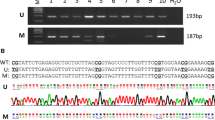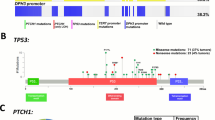Abstract
Basal cell carcinoma (BCC) is the most common malignant human neoplasm characterized by slow growth and virtual absence of metastases. Recently, it has become evident that along with genetic mutations epigenetic alterations play a key role in the pathogenesis of human cancer. We searched for promoter methylation of hMLH1, RASSF1A, DAPK, APC, DCR1 and DCR2 genes and BRAF mutations in BCCs in association with the clinicopathological parameters and the histological subtypes of the tumours. Fifty-two BCCs, 17 FFPE along with 35 fresh tissue samples with matching normal tissues for 26 cases were analyzed by methylation-specific PCR to assess the methylation status of hMLH1, RASSF1A, DAPK, APC, DCR1 and DCR2 genes after sodium bisulfite treatment of the tumour and normal DNA. hMLH1 and DCR1 gene expression was investigated by immunohistochemistry. BRAF mutations were studied by high resolution melting analysis. Methylation was detected at a variable frequency of 44, 33, 32.5, 32 and 14 % of DCR2, APC, DCR1, RASSF1 and DAPK promoters, respectively, whereas methylation of hMLH1 promoter was absent. No BRAF mutations were found. There was no correlation between the frequency of the promoter methylation of the above-mentioned genes and the clinicopathological features or the histological subtypes of the tumours. The relatively high frequency of RASSF1A, DCR1, DCR2 and APC promoter methylation may imply that methylation constitutes an important pathway in the tumourigenesis of BCC that could provide new opportunities in developing epigenetic therapies for BCC patients. Nevertheless, further studies are needed to establish the above-mentioned hypothesis.




Similar content being viewed by others
References
LeBoit PE, Burg G, Weedon D, Sarasain A (2006) World Health Organization classification of tumours. Pathology and genetics of skin tumours. IARC, Lyon
Li C, Chi S, Xie J (2011) Hedgehog signaling in skin cancers. Cell Signal 23(8):1235–1243
Herman JG, Baylin SB (2003) Gene silencing in cancer in association with promoter hypermethylation. N Engl J Med 349(21):2042–2054
Esteller M (2002) CpG island hypermethylation and tumour suppressor genes: a booming present, a brighter future. Oncogene 21:5427–5440
Jones PA, Baylin SB (2002) The fundamental role of epigenetic events in cancer. Nat Rev Genet 3(6):415–428 (Review)
Shivapurkar N, Stastny V, Suzuki M, Wistuba II, Li L, Zheng Y, Feng Z, Hol B, Prinsen C, Thunnissen FB, Gazdar AF (2007) Application of a methylation gene panel by quantitative PCR for lung cancers. Cancer Lett 247(1):56–71
Mani S, Herceg Z (2010) DNA demethylating agents and epigenetic therapy of cancer. Adv Genet 70:327–340
van Doorn R, Gruis NA, Willemze R, van der Velden PA, Tensen CP (2005) Aberrant DNA methylation in cutaneous malignancies. Semin Oncol 32(5):479–487 (Review)
Esteller M, Catasus L, Matias-Guiu X, Mutter GL, Prat J, Baylin SB, Herman JG (1999) hMLH1 promoter hypermethylation is an early event in human endometrial tumourigenesis. Am J Pathol 155(5):1767–1772
Fleisher AS, Esteller M, Wang S, Tamura G, Suzuki H, Yin J, Zou TT, Abraham JM, Kong D, Smolinski KN, Shi YQ, Rhyu MG, Powell SM, James SP, Wilson KT, Herman JG, Meltzer SJ (1999) Hypermethylation of the hMLH1 gene promoter in human gastric cancers with microsatellite instability. Cancer Res 59(5):1090–1095
Herman JG, Umar A, Polyak K, Graff JR, Ahuja N, Issa JP, Markowitz S, Willson JK, Hamilton SR, Kinzler KW, Kane MF, Kolodner RD, Vogelstein B, Kunkel TA, Baylin SB (1998) Incidence and functional consequences of hMLH1 promoter hypermethylation in colorectal carcinoma. Proc Natl Acad Sci USA 95(12):6870–6875
Shivapurkar N, Toyooka S, Toyooka KO, Reddy J, Miyajima K, Suzuki M, Shigematsu H, Takahashi T, Parikh G, Pass HI, Chaudhary PM, Gazdar AF (2004) Aberrant methylation of trail decoy receptor genes is frequent in multiple tumour types. Int J Cancer 109(5):786–792
Donninger H, Vos MD, Clark GJ (2007) The RASSF1A tumour suppressor. J Cell Sci 120(Pt 18):3163–3172
Bialik S, Kimchi A (2006) The death-associated protein kinases: structure, function, and beyond. Annu Rev Biochem 75:189–210
Fearnhead NS, Britton MP, Bodmer WF (2001) The ABC of APC. Hum Mol Genet 10(7):721–733
Bello DM, Ariyan CE, Carvajal RD (2013) Melanoma mutagenesis and aberrant cell signaling. Cancer Control 20(4):261–281
Brait M, Loyo M, Rosenbaum E, Ostrow KL, Markova A, Papagerakis S, Zahurak M, Goodman SM, Zeiger M, Sidransky D, Umbricht CB, Hoque MO (2012) Correlation between BRAF mutation and promoter methylation of TIMP3, RARβ2 and RASSF1A in thyroid cancer. Epigenetics 7(7):710–719
Hu S, Liu D, Tufano RP, Carson KA, Rosenbaum E, Cohen Y, Holt EH, Kiseljak-Vassiliades K, Rhoden KJ, Tolaney S, Condouris S, Tallini G, Westra WH, Umbricht CB, Zeiger MA, Califano JA, Vasko V, Xing M (2006) Association of aberrant methylation of tumour suppressor genes with tumour aggressiveness and BRAF mutation in papillary thyroid cancer. Int J Cancer 119(10):2322–2329
van Roon EH, Boot A, Dihal AA, Ernst RF, van Wezel T, Morreau H, Boer JM (2013) BRAF mutation-specific promoter methylation of FOX genes in colorectal cancer. Clin Epigenetics 5(1):2
Crowson AN (2006) Basal cell carcinoma: biology, morphology and clinical implications. Mod Pathol 19 Suppl 2:127–147 (Review)
Saetta AA, Aroni K, Stamatelli A, Lazaris AC, Patsouris E (2005) Expression of mismatch repair enzymes, hMLH1 and hMSH2 is not associated with microsatellite instability and P53 protein accumulation in basal cell carcinoma. Arch Dermatol Res 297(3):99–107
Herman JG, Graff JR, Myöhänen S, Nelkin BD, Baylin SB (1996) Methylation-specific PCR: a novel PCR assay for methylation status of CpG islands. Proc Natl Acad Sci USA 93(18):9821–9826
Busam KJ (2013) Molecular pathology of melanocytic tumours. Semin Diagn Pathol 30(4):362–374
Sathyanarayana UG, Moore AY, Li L, Padar A, Majmudar K, Stastny V, Makarla P, Suzuki M, Minna JD, Feng Z, Gazdar AF (2007) Sun exposure related methylation in malignant and non-malignant skin lesions. Cancer Lett 245(1–2):112–120
Takeuchi T, Liang SB, Ohtsuki Y (2002) Downregulation of expression of a novel cadherin molecule, T-cadherin, in basal cell carcinoma of the skin. Mol Carcinog 35(4):173–179
Lodygin D, Yazdi AS, Sander CA, Herzinger T, Hermeking H (2003) Analysis of 14-3-3 sigma expression in hyperproliferative skin diseases reveals selective loss associated with CpG-methylation in basal cell carcinoma. Oncogene 22(35):5519–5524
Brinkhuizen T, van den Hurk K, Winnepenninckx VJ, de Hoon JP, van Marion AM, Veeck J, van Engeland M, van Steensel MA (2012) Epigenetic changes in basal cell carcinoma affect SHH and WNT signaling components. PLoS ONE 7(12):e51710
Goldberg M, Rummelt C, Laerm A, Helmbold P, Holbach LM, Ballhausen WG (2006) Epigenetic silencing contributes to frequent loss of the fragile histidine triad tumour suppressor in basal cell carcinomas. Br J Dermatol 155(6):1154–1158
Heitzer E, Bambach I, Dandachi N, Horn M, Wolf P (2010) PTCH promoter methylation at low level in sporadic basal cell carcinoma analysed by three different approaches. Exp Dermatol 19(10):926–928
Libra M, Malaponte G, Bevelacqua V, Siciliano R, Castrogiovanni P, Fulvi A, Micali G, Ligresti G, Mazzarino MC, Stivala F, Travali S, McCubrey JA (2006) Absence of BRAF gene mutation in non-melanoma skin tumours. Cell Cycle 5(9):968–970
Reifenberger J, Wolter M, Knobbe CB, Köhler B, Schönicke A, Scharwächter C, Kumar K, Blaschke B, Ruzicka T, Reifenberger G (2005) Somatic mutations in the PTCH, SMOH, SUFUH and TP53 genes in sporadic basal cell carcinomas. Br J Dermatol 152(1):43–51
Xing M, Cohen Y, Mambo E, Tallini G, Udelsman R, Ladenson PW, Sidransky D (2004) Early occurrence of RASSF1A hypermethylation and its mutual exclusion with BRAF mutation in thyroid tumourigenesis. Cancer Res 64(5):1664–1668
Issa JP (2003) Age-related epigenetic changes and the immune system. Clin Immunol 109(1):103–108 (Review)
Conway K, Edmiston SN, Khondker ZS, Groben PA, Zhou X, Chu H, Kuan PF, Hao H, Carson C, Berwick M, Olilla DW, Thomas NE (2011) DNA-methylation profiling distinguishes malignant melanomas from benign nevi. Pigment Cell Melanoma Res 24(2):352–360
Hassel JC, Sucker A, Edler L, Kurzen H, Moll I, Stresemann C, Spieth K, Mauch C, Rass K, Dummer R, Schadendorf D (2010) MGMT gene promoter methylation correlates with tolerance of temozolomide treatment in melanoma but not with clinical outcome. Br J Cancer 103(6):820–826
Margetts CD, Astuti D, Gentle DC, Cooper WN, Cascon A, Catchpoole D, Robledo M, Neumann HP, Latif F, Maher ER (2005) Epigenetic analysis of HIC1, CASP8, FLIP, TSP1, DCR1, DCR2, DR4, DR5, KvDMR1, H19 and preferential 11p15.5 maternal-allele loss in von Hippel-Lindau and sporadic phaeochromocytomas. Endocr Relat Cancer 12(1):161–172
van Noesel MM, van Bezouw S, Salomons GS, Voûte PA, Pieters R, Baylin SB, Herman JG, Versteeg R (2002) Tumour-specific down-regulation of the tumour necrosis factor-related apoptosis-inducing ligand decoy receptors DcR1 and DcR2 is associated with dense promoter hypermethylation. Cancer Res 62(7):2157–2161
Nakamura N, Carney JA, Jin L, Kajita S, Pallares J, Zhang H, Qian X, Sebo TJ, Erickson LA, Lloyd RV (2005) RASSF1A and NORE1A methylation and BRAFV600E mutations in thyroid tumours. Lab Investig 85(9):1065–1075
van Engeland M, Weijenberg MP, Roemen GM, Brink M, de Bruïne AP, Goldbohm RA, van den Brandt PA, Baylin SB, de Goeij AF, Herman JG (2003) Effects of dietary folate and alcohol intake on promoter methylation in sporadic colorectal cancer: the Netherlands cohort study on diet and cancer. Cancer Res 63(12):3133–3137
Russo AL, Thiagalingam A, Pan H, Califano J, Cheng KH, Ponte JF, Chinnappan D, Nemani P, Sidransky D, Thiagalingam S (2005) Differential DNA hypermethylation of critical genes mediates the stage-specific tobacco smoke-induced neoplastic progression of lung cancer. Clin Cancer Res 11(7):2466–2470
Acknowledgments
The authors are grateful to PG Tsioli, S. Tsikalakis and I. Giannopoulou for performing experiments with the normal tissue specimens.
Conflict of interest
The authors declare that they have no conflict of interest.
Author information
Authors and Affiliations
Corresponding author
Rights and permissions
About this article
Cite this article
Stamatelli, A., Vlachou, C., Aroni, K. et al. Epigenetic alterations in sporadic basal cell carcinomas. Arch Dermatol Res 306, 561–569 (2014). https://doi.org/10.1007/s00403-014-1454-x
Received:
Revised:
Accepted:
Published:
Issue Date:
DOI: https://doi.org/10.1007/s00403-014-1454-x




